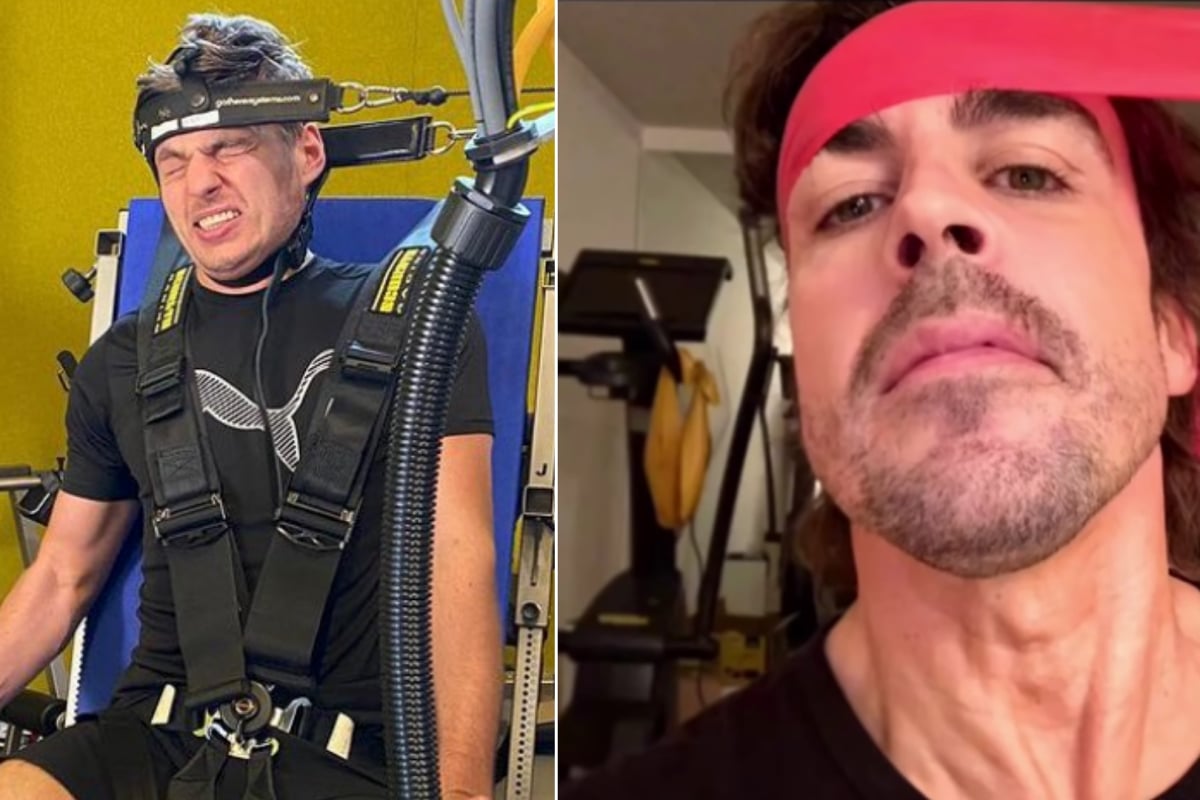
Withstanding G-forces and avoiding whiplash: F1 drivers and their neck muscles
Withstanding G-forces and avoiding whiplash: F1 drivers and their neck muscles

Formula 1 drivers need a thick skin – and they also need a thick neck.
The world's top drivers push their bodies to the absolute limit to endure the demands of the world's fastest sport and training the neck is vital to last the hour-and-a-half or so needed to finish Grands Prix at high speed.
When cornering, braking and accelerating, Formula 1 drivers must endure extreme G-forces. The stronger the neck muscles, the less chance of suffering serious injury to that area in a crash, and also the longer a driver can last in the race.
The neck should therefore not be forgotten in the fitness routine.
Withstanding G-forces
The fluctuations of speed, and gravity, are greater in F1 than in any other motorsport.
Drivers can experience up to 5g after in some of the most aggressive braking zones and some of the more sweeping, high-speed corners.
READ MORE: Hamilton on Verstappen: Why should I have a problem with him?
Accidents on the track are also a massive spiker for G-forces. Romain Grosjean experienced a scarcely fathomable 67g as he smashed into the barrier at the 2020 Bahrain Grand Prix, taking his body weight to almost 4 tonnes at the point of impact.
Reigning champion Max Verstappen was pitched into the barrier at 51g, when he collided with Lewis Hamilton at Copse in the 2021 British Grand Prix. He was taken to hospital as a precaution and fortunately suffered no lasting damage.
Whiplash and how it works
When a driver crashes, their head is often thrown around in the cockpit as a result of the collision. Whiplash is therefore a very real risk, but that can be counteracted if the the neck muscles are well trained.
Whiplash, in serious cases can mean permanent neck pain, headaches and back pain – as well as stiffness in the neck, concentration problems, severe fatigue and tinnitus (ringing in the ears). In the most severe cases, it can even cause forgetfulness, mood swings and tingling in the fingers, so it is vitally important for elite motorsport athletes to avoid this type of injury.
The tricky thing about whiplash is that it cannot always be properly diagnosed, especially when the adrenaline is still rushing through the body. If the neck muscles are not strong enough, a driver will tire much more quickly and will not feel comfortable, which can lead to relatively long delays in hand-eye coordination. If that happens, then mistakes on the track are then quickly made, so it's easy to see why training against whiplash is absolutely vital.
Norris shows how to train the neck
Lando Norris, in this TikTok, shows the exercises he does to strengthen his neck muscles. Just one of the many, many things Formula 1 drivers do during the offseason.
A bit like us here at GPFans, they certainly do not sit still during the winter!
@landonorris Neck day< /p> ♬ Rumble - Skrillex & Fred again.. & Flowdan
Related
Change your timezone:
Latest News

F1 champion reveals 'painful' contract clause that cost him HUNDREDS OF THOUSANDS
- 59 minutes ago

F1 legend's ICONIC car put up for sale in UK
- 1 hour ago

Incredible statistic puts Verstappen AHEAD of Hamilton record
- 2 hours ago

Fierce rival calls Hamilton F1's GOAT in surprise admission
- 3 hours ago

Mercedes star tipped to replace struggling driver THIS season
- Today 11:57
- 1

F1 legend issues DAMNING verdict on proposed rule change
- Today 10:57
Related news

F1 Drive to Survive Season 6: Official episode titles and guide - watch NOW

Creating the perfect CHRISTMAS F1 driver lineup

Best F1 moments of 2023 season - from crashes to comebacks

Hamilton delivers Mercedes F1 title fight verdict amid Red Bull domination
F1 Standings

Drivers
- Oliver Bearman
- Charles Leclerc
- Carlos Sainz
- Lando Norris
- Oscar Piastri
- Pierre Gasly
- Esteban Ocon
- Sergio Pérez
- Max Verstappen
- Alexander Albon
- Logan Sargeant
- Lewis Hamilton
- George Russell
- Nico Hülkenberg
- Kevin Magnussen
- Fernando Alonso
- Lance Stroll
- Valtteri Bottas
- Zhou Guanyu
- Daniel Ricciardo
- Yuki Tsunoda
Races
-
 Gulf Air Grand Prix of Bahrain 2024
Gulf Air Grand Prix of Bahrain 2024
-
 Saudi Arabian Grand Prix 2024
Saudi Arabian Grand Prix 2024
-
 Grand Prix of Australia 2024
Grand Prix of Australia 2024
-
 MSC Cruises Grand Prix of Japan 2024
MSC Cruises Grand Prix of Japan 2024
-
 Grand Prix of China 2024
Grand Prix of China 2024
-
 Miami Grand Prix 2024
Miami Grand Prix 2024
-
 Gran Premio dell'Emilia Romagna 2024
Gran Premio dell'Emilia Romagna 2024
-
 Grand Prix of Monaco 2024
Grand Prix of Monaco 2024
-
 Grand Prix du Canada 2024
Grand Prix du Canada 2024
-
 Gran Premio de España 2024
Gran Premio de España 2024
-
 Grand Prix of Austria 2024
Grand Prix of Austria 2024
-
 Grand Prix of Great Britain 2024
Grand Prix of Great Britain 2024
-
 Grand Prix of Hungary 2024
Grand Prix of Hungary 2024
-
 Grand Prix of Belgium 2024
Grand Prix of Belgium 2024
-
 Heineken Dutch Grand Prix 2024
Heineken Dutch Grand Prix 2024
-
 Grand Prix of Italy 2024
Grand Prix of Italy 2024
-
 Grand Prix of Azerbaijan 2024
Grand Prix of Azerbaijan 2024
-
 Grand Prix of Singapore 2024
Grand Prix of Singapore 2024
-
 Grand Prix of the United States 2024
Grand Prix of the United States 2024
-
 Gran Premio de la Ciudad de Mexico 2024
Gran Premio de la Ciudad de Mexico 2024
-
 Grande Prêmio de São Paulo 2024
Grande Prêmio de São Paulo 2024
-
 Heineken Silver Las Vegas Grand Prix 2024
Heineken Silver Las Vegas Grand Prix 2024
-
 Qatar Grand Prix 2024
Qatar Grand Prix 2024
-
 Grand Prix of Abu Dhabi 2024
Grand Prix of Abu Dhabi 2024
About GPFans
GPFans is a multi-platform, multi-language brand dedicated to Formula One coverage. We bring you all the ins and outs of the sport, 24/7, everything from up-to-the-minute news and features to the latest viral stories and clips.We believe that a new generation of exciting, outspoken drivers will make F1 more popular than ever before, and we want to give our users access to as much of their heroes as possible, on and off the track. From Lewis Hamilton to Max Verstappen, Daniel Ricciardo to Sebastian Vettel, we provide in-depth analysis of every every Grand Prix in the season, from Australia to Abu Dhabi.
With Formula One under the new ownership of Liberty Media, how the sport is being covered is evolving, and GPFans will look to be at the heart of this progression into new media, as one of the fastest-growing sites covering the king of motorsports.
Follow us on your favorite social media channel
Corporate & Media
 Innovatieweg 20C
Innovatieweg 20C7007 CD, Doetinchem, Netherlands
+31645516860



















 Gulf Air Grand Prix of Bahrain 2024
Gulf Air Grand Prix of Bahrain 2024  Saudi Arabian Grand Prix 2024
Saudi Arabian Grand Prix 2024  Grand Prix of Australia 2024
Grand Prix of Australia 2024  MSC Cruises Grand Prix of Japan 2024
MSC Cruises Grand Prix of Japan 2024  Grand Prix of China 2024
Grand Prix of China 2024  Gran Premio dell'Emilia Romagna 2024
Gran Premio dell'Emilia Romagna 2024  Grand Prix of Monaco 2024
Grand Prix of Monaco 2024  Grand Prix du Canada 2024
Grand Prix du Canada 2024  Gran Premio de España 2024
Gran Premio de España 2024  Grand Prix of Austria 2024
Grand Prix of Austria 2024  Grand Prix of Hungary 2024
Grand Prix of Hungary 2024  Grand Prix of Belgium 2024
Grand Prix of Belgium 2024  Grand Prix of Azerbaijan 2024
Grand Prix of Azerbaijan 2024  Grand Prix of Singapore 2024
Grand Prix of Singapore 2024  Gran Premio de la Ciudad de Mexico 2024
Gran Premio de la Ciudad de Mexico 2024  Grande Prêmio de São Paulo 2024
Grande Prêmio de São Paulo 2024  Qatar Grand Prix 2024
Qatar Grand Prix 2024  Grand Prix of Abu Dhabi 2024
Grand Prix of Abu Dhabi 2024